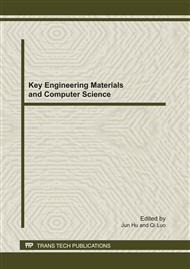p.180
p.185
p.191
p.196
p.202
p.210
p.216
p.222
p.228
Preparation and Properties of the Drug-Loaded Films of Polyvinyl Alcohol-Graft-Fibroin Peptides
Abstract:
Research of biomaterials made from synthesized polymer and naturally occurring macromolecules is a promising subject. The paper reported a series of drug-loaded films manufactured by a method of solution casting, taking polyvinyl alcohol-graft-fibroin peptides (PVA-g-FP) obtained by a graft copolymerization of PVA with allyl fibroin peptides (AFP) as the polymer matrix and, the ornidazole as the model drug. The mechanical property, moisture content, dissolution degree,water absorption and water-vapor transmission rate of the films were determined respectively, and the crystalline of the films were characterized via X-ray diffraction, the morphology of the films and the dispersity profile of the drug ornidazole loaded in the matrix of PVA-g-FP were investigated via the scanning electronic microscopy (SEM). It was concluded that: with the increase of the graft efficiency of FP in the PVA-g-FP films, the mechanical property and the degree of crystalline reduced gradually; but the moisture content, dissolution degree and water-vapor transmission rate rised gradually, and especially, the dispersity of the drug loaded in the PVA-g-FP matrix improved evidently. The results may be useful in exploiting biomaterials such as artificial skin, drug delivery systems and wound dressings.
Info:
Periodical:
Pages:
202-209
Citation:
Online since:
August 2011
Keywords:
Price:
Сopyright:
© 2011 Trans Tech Publications Ltd. All Rights Reserved
Share:
Citation:


